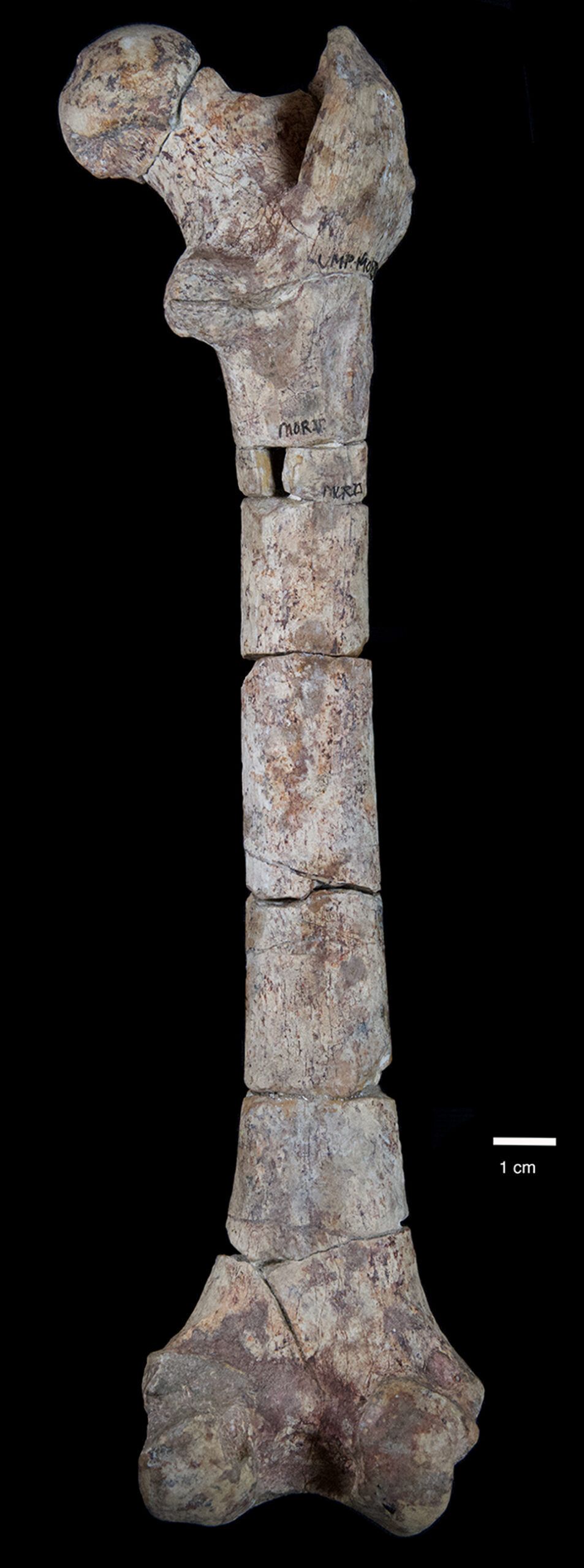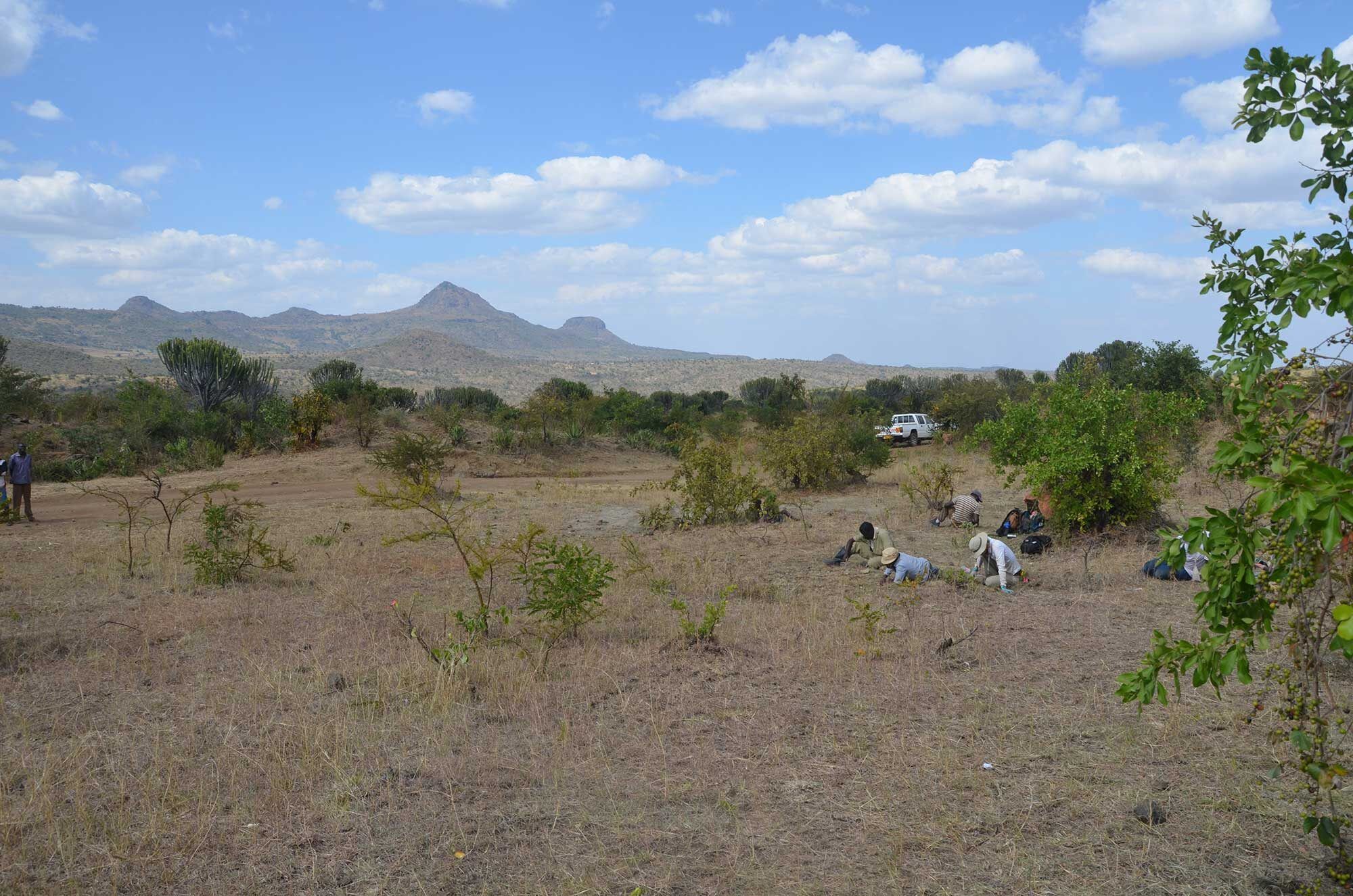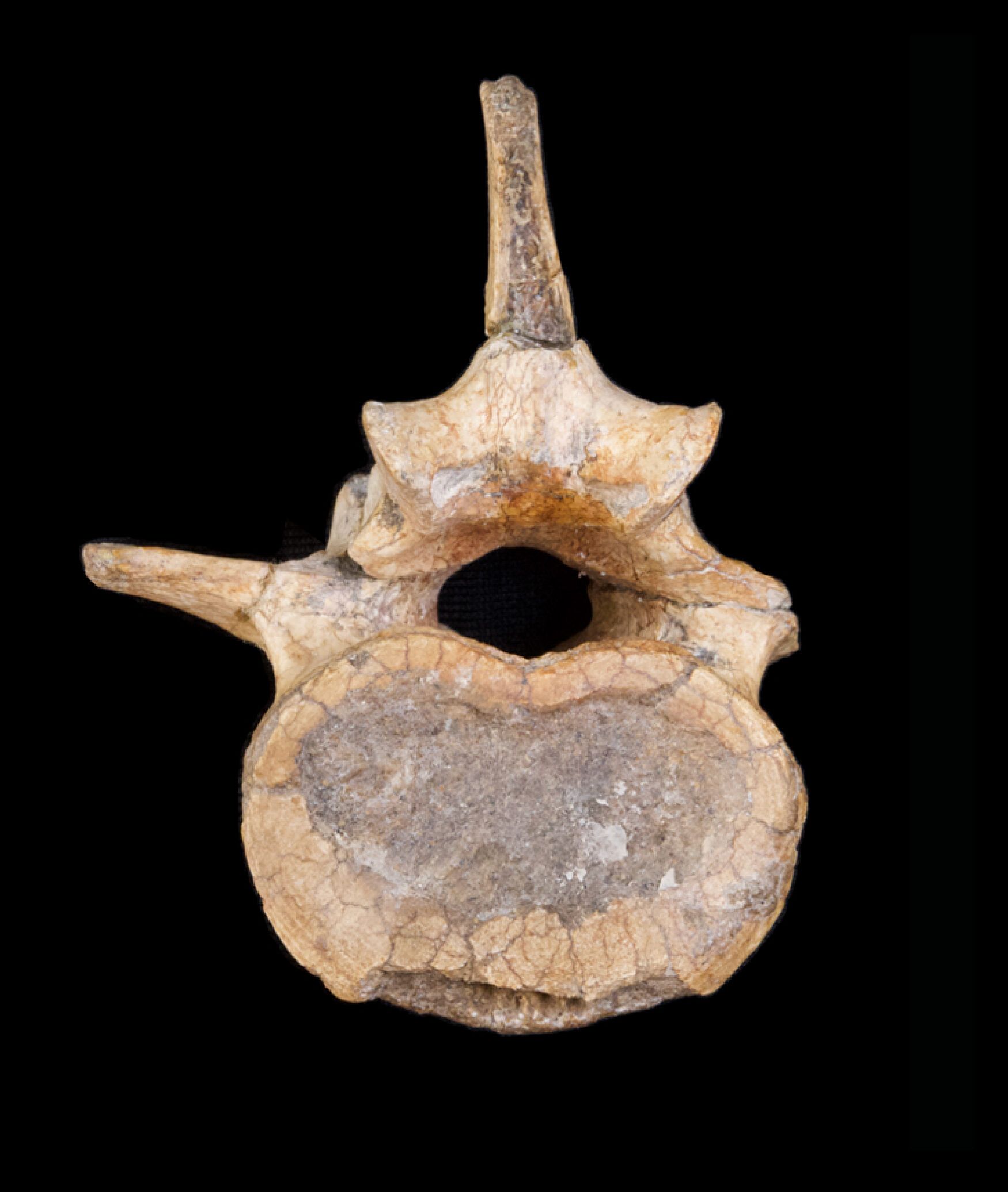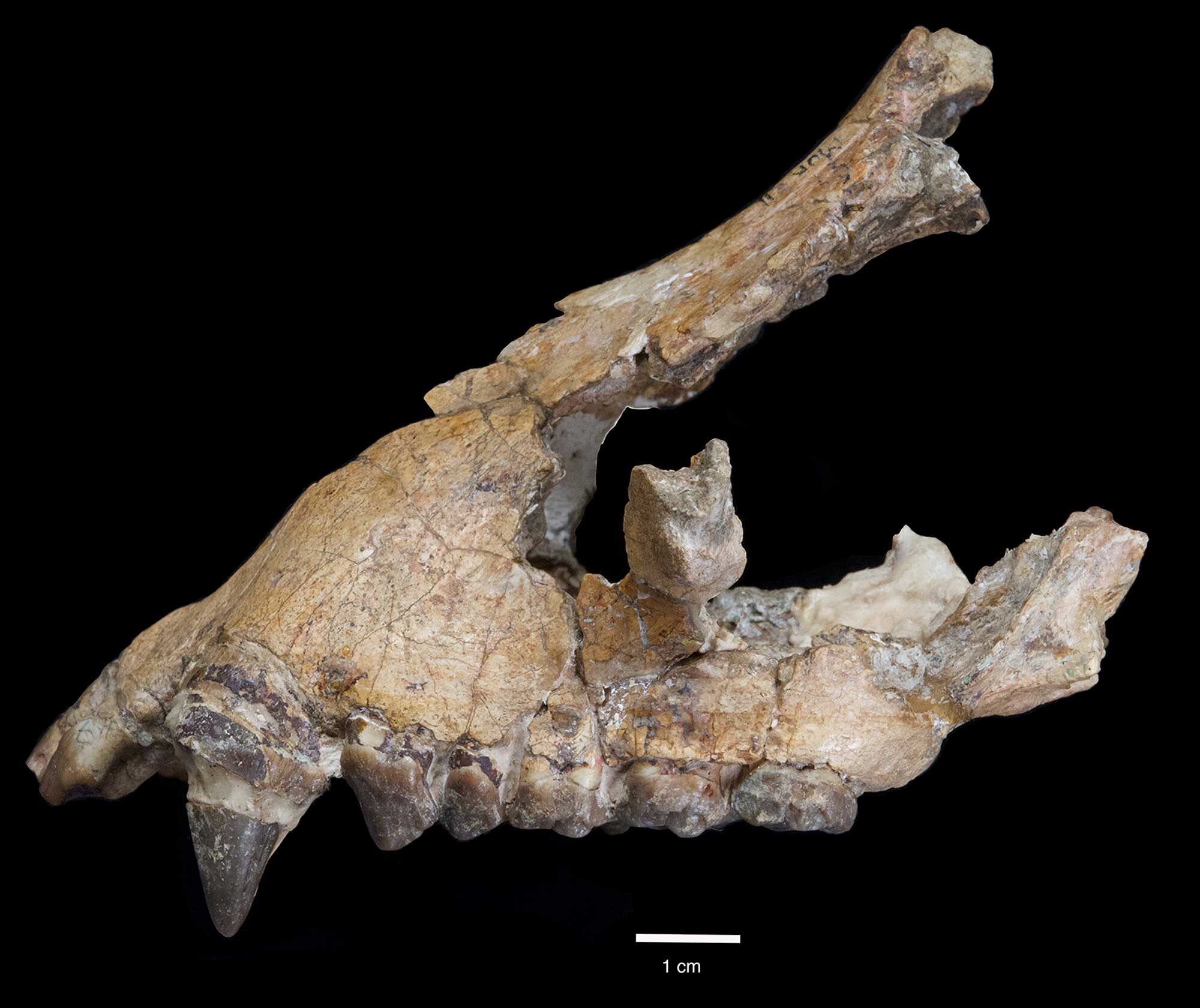Insight into the Upright Evolution of Apes
Anthropologists have long thought that our ape ancestors evolved an upright torso in order to pick fruit in forests, but new research from the University of Michigan suggests a life in open woodlands and a diet that included leaves drove apes’ upright stature.
The findings shed light on ape origins and push back the origin of grassy woodlands from between 7 million and 10 million years ago to 21 million years ago in equatorial Africa, during the Early Miocene.
Fruit grows on the spindly peripheries of trees. To reach it, large apes need to distribute their weight on branches stemming from the trunk, then reach out with their hands toward their prize. This is much easier if an ape is upright because it can more easily grab onto different branches with its hands and feet. If its back is horizontal, then its hands and feet are generally underneath the body, making it much harder to move outward to the smaller branches of a tree—especially if the ape is large bodied.

This is how modern day apes reach fruit, and, it’s been theorized, that’s why apes evolved to be upright, according to U-M researchers Laura MacLatchy and John Kingston.
But new research centered around a 21-million-year-old fossil ape called Morotopithecus and led by MacLatchy suggests this might not be the case. Instead, researchers think early apes ate leaves and lived in a seasonal woodland with a broken canopy and open, grassy areas. The researchers suggest this landscape, instead of fruit in closed canopy forests, drove apes’ upright stature.

Their results are published in Science and are bolstered by a companion paper examining these paleo grassy woodland habitats, published in the same issue of the journal.
“The expectation was: We have this ape with an upright back. It must be living in forests and it must be eating fruit. But as more and more bits of information became available, the first surprising thing we found was that the ape was eating leaves. The second surprise was that it was living in woodlands,” said MacLatchy, a paleoanthropologist and professor in the U-M Department of Anthropology.

The two papers grew out of a U.S. National Science Foundation-funded collaboration of international paleontologists, collectively known as the Research on Eastern African Catarrhine and Hominoid Evolution project or REACHE, each of whom focus on different aspects of early ape paleoenvironments. The study led by MacLatchy focuses on a 21-million-year-old site called the Moroto site in eastern Uganda.
There, the group, which included U-M researchers William Sanders and Miranda Cosman, examined fossils found in a single stratigraphic layer, including fossils of the oldest, clearly documented ape, Morotopithecus. Also within this layer were fossils of other mammals, ancient soils called paleosols, and tiny silica particles from plants called phytoliths. The researchers used these lines of evidence to recreate the ancient environment of Morotopithecus.
MacLatchy and Kingston discovered that the plants living in this landscape were what’s called “water stressed,” meaning they lived through seasonal periods of rain and of aridity. This also means that at least part of the year, apes had to rely on something other than fruit to survive. Together, these findings indicate that Morotopithecus lived in an open woodland punctuated by broken canopy forests composed of trees and shrubs.
“These open environments have been invoked to explain human origins, and it was thought that you started to get these more open, seasonal environments between 10 and 7 million years ago,” MacLatchy said. “Such an environmental shift is thought to have been selected for terrestrial bipedalism—our ancestors started striding around on the ground because the trees were further apart.
“Now that we’ve shown that such environments were present at least 10 million years before bipedalism evolved, we need to really rethink human origins, too.”
The first clue that these ancient apes were eating leaves was in the apes’ molars. The molars were very “cresty”: they were craggy, with peaks and valleys. Molars like this are used for tearing fibrous leaves apart, while molars used for eating fruit are typically more rounded, MacLatchy said.

The researchers also examined the apes’ dental enamel, as well as the dental enamel of other mammals found in the same stratigraphic layer. They found that isotopic ratios—the abundance of two isotopes of the same element—in their dental enamel showed that the apes and other mammals had been eating water stressed C3 plants that are more common in open woodland or grassy woodland environments today. C3 plants are primarily woody shrubs and trees while C4 plants are arid-adapted grasses.
“Putting together the locomotion, the diet and the environment, we basically discovered a new model for ape origins,” MacLatchy said. “In anthropology, we care a lot about ape evolution because humans are closely related to apes and features like lower back stability represent an arboreal adaptation that may have ultimately given rise to bipedality in humans.”
Early Miocene C4 grasses and open woodlands
Previously, researchers believed equatorial Africa during the Early Miocene was thickly carpeted with forest, and that open seasonal woodlands and grasslands evolved only between 7 million and 10 million years ago.
But the second paper uses a set of environmental proxies to reconstruct the vegetation structure from nine fossil ape sites across Africa, including the Moroto site, during the Early Miocene. These proxies revealed that C4 grasses were “everywhere” at the fossil ape sites during that time period, said Kingston, a biological anthropologist and associate professor in the U-M Department of Anthropology.
“This paper looks at all these sites, pulls all this data together, and says, ‘Look, no matter how you evaluate the data, there’s no way you can escape the fact that all these proxies are converging on the same place—namely, that these environments are open, and they’re open with C4 grasses,” he said.
“For the first time, we’re showing that these grasses are widespread, and it’s this general context of open seasonal woodland ecosystems that were integral in shaping the evolution of different mammalian lineages, including and especially in our case, how different ape lineages evolved.”
The nine sites are scattered across eastern equatorial Africa, enough to develop a “regional picture” of what the sites’ landscapes looked like in the Early Miocene, Kingston said. During this time, the East African Rift was forming. Earth was pulling apart. As a result, the entire region was uplifted, causing huge variation in topography, and therefore, regional climate and vegetation.
“There’s mountains and volcanoes, there’s cliffs and escarpments and valleys related to the rifting,” Kingston said. “The landscape is just physically highly variable, and that, no doubt, is related to the vegetation heterogeneity.”
To reconstruct the paleoenvironment at each location, the researchers used carbon isotope analyses of ancient soil organic matter, plant wax biomarkers and phytoliths found at each site. The carbon isotope analyses revealed that a wide range of plants lived in the grasslands, ranging from those that comprise closed canopy to wooded grasslands.

The wax biomarkers—left over from the waxy material that protects leaves—also indicate a large variety of shrubs and trees as well as grasses. Phytoliths—microscopic biosilica bodies that give plants their structure as well as a defense against being eaten—can tell the researchers the proportion of C4 grasses at a given site and provide further evidence for abundant C4 grasses.
After using these proxies to rebuild the paleoenvironments at these nine sites, the researchers found that C4 grasses were abundant across eastern equatorial Africa, and were a key part of the landscape’s heterogeneous habitats. Their data also pushes back the oldest evidence of C4 grass-dominated habitats in Africa and globally by more than 10 million years.
“The findings have transformed what we thought we knew about early apes, and the origin for where, when and why they navigate through the trees and on the ground in multiple different ways,” said Robin Bernstein, program director for biological anthropology at the National Science Foundation.
“For the first time, by combining diverse lines of evidence, this collaborative research team tied specific aspects of early ape anatomy to nuanced environmental changes in their habitat in eastern Africa, now revealed as more open and less forested than previously thought. The effort outlines a new framework for future studies regarding ape evolutionary origins.”
Written by University of Michigan News
Photos by J. Kingston & L. MacLatchy
